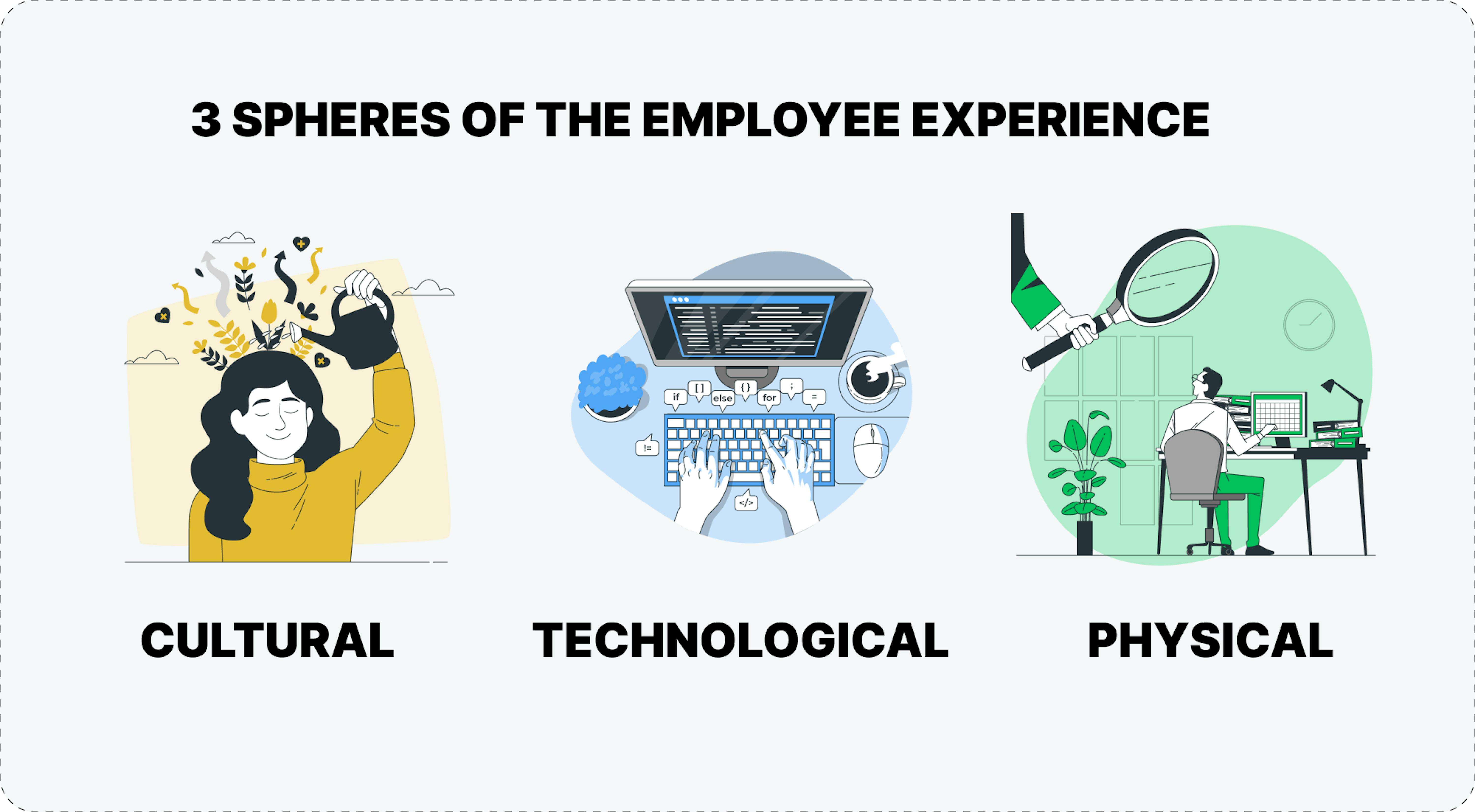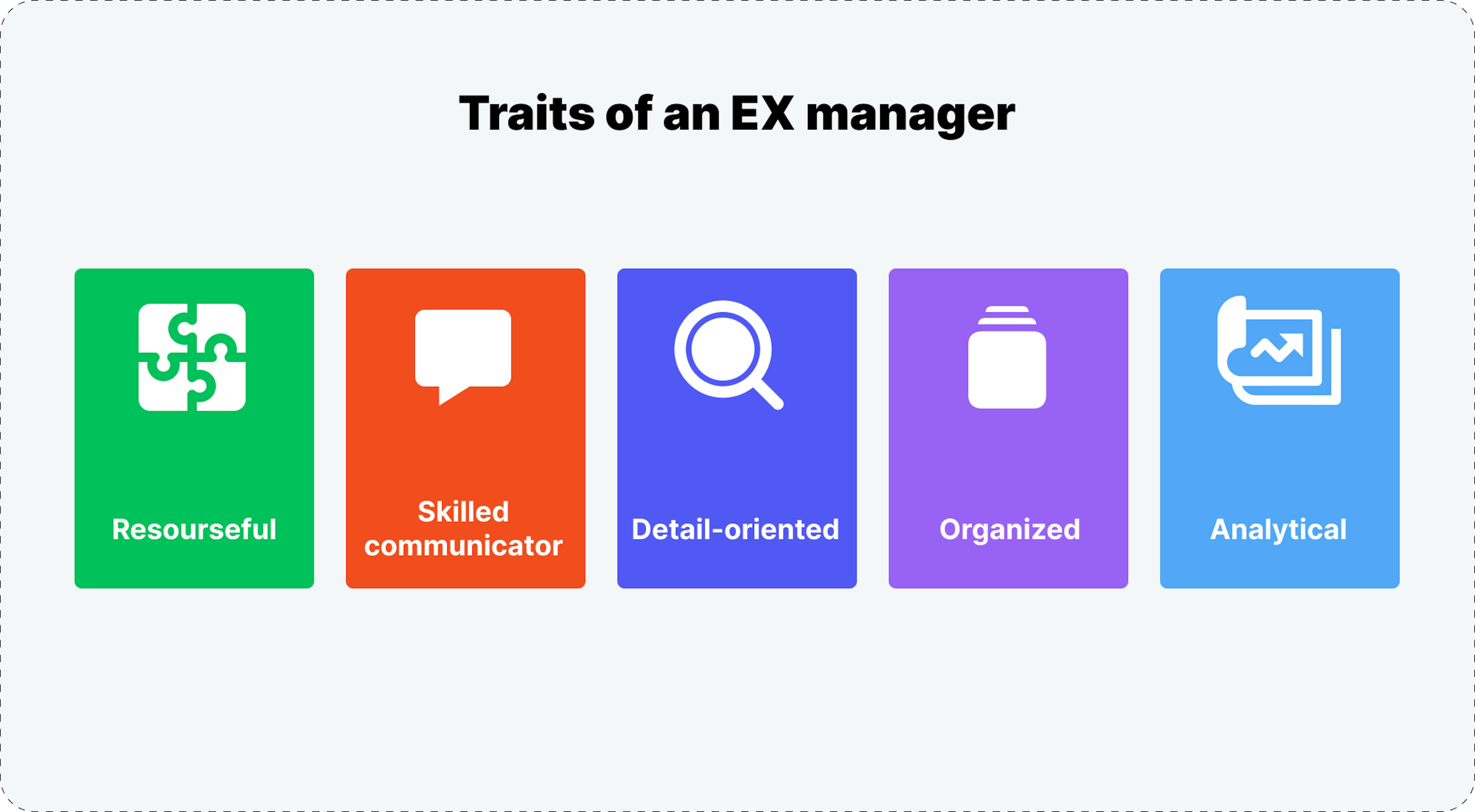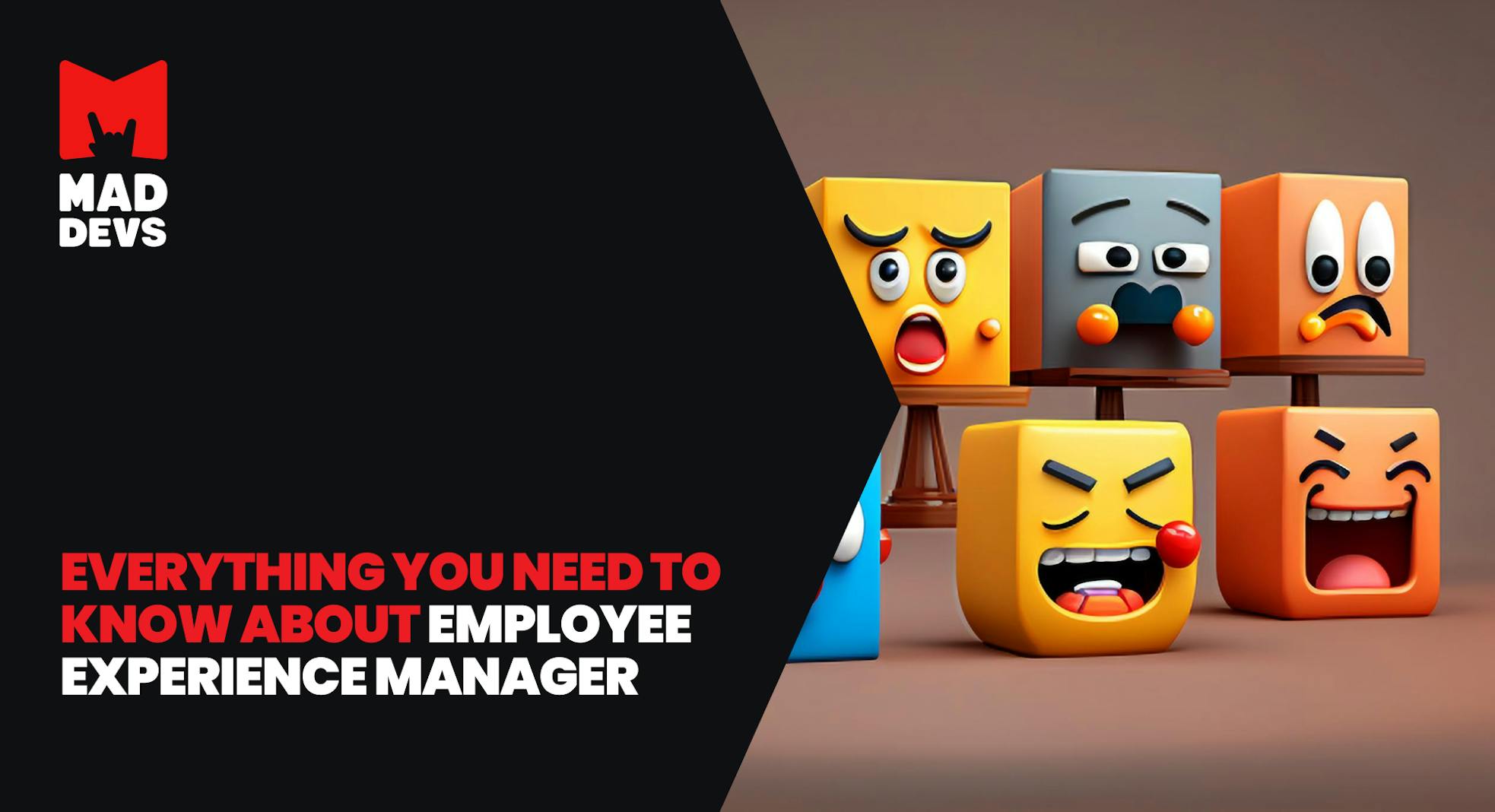Today, when looking for a job, candidates seek more than just a paycheck; they aspire to be part of a company that provides growth opportunities, mental health resources and fosters a positive work environment. That is what employee experience managers do.
This article offers a comprehensive overview of employee experience management (EXM), including what it is, why it is important, and what are its benefits. We also discuss the role of the employee experience manager in the employee lifecycle and explore the best practices for EXM.
The rise of employee experience management
In recent years, companies have started paying more attention to how their employees feel at work, from the very beginning to the moment they leave for another opportunity.
Jacob Morgan, a four-time best-selling author known for The Employee Experience Advantage, breaks down the employee experience into three main parts:

Tech stuff
What technology employees use and how is a big part of their work experience. It is essential to ensure they have the right modern tools that are easy to use. Keeping up with the latest tech updates helps employees feel confident and do their jobs well.Workplace vibes
The look and feel of the place where employees work matter. Is the office welcoming? Is the desk comfy? Small improvements in the workspace, or even in a home office, can boost teamwork, motivation, and overall productivity. Even the implementation of virtual collaboration tools will help maintain seamless communication, project management, and a feeling of connection for remote teams.Company feel
Company culture isn't just about parties; it is about how secure and motivated employees feel day-to-day. This includes benefits and the leadership style. Ask yourself: Do employees feel heard and supported? Making the employee experience great means putting the employee's feelings first, which involves digging into how things are structured in the company.
A 2021 global survey by Willis Towers Watson found that COVID-19 changed everything. Now, 92% of employers say improving employee experience is a top priority for the next 3 years. Before the pandemic, only 52% thought it was that critical.
Several factors contribute to adopting employee experience management in modern work conditions. They are:
- Digital transformation: Emerging digital technologies have changed the way organizations operate.
- New generations: Younger employees have different expectations and priorities than the previous generations.
- The rise of the gig economy: In the gig economy, workers are more mobile and less likely to stay with one company for their entire careers.
- The changing nature of work: Work has become more remote and hybrid, and organizations need to adapt strategies to meet the needs of this new workforce.
- Increasing competition: Companies increasingly focus on differentiating themselves from their competitors by creating a positive work environment and attracting top talent.
As of 2023, the Employee Experience role has secured the 5th position among the 25 fastest-growing job titles in LinkedIn's Fastest-Growing Job Titles list. This marks the first time this role has been included in the rankings.
What is an employee experience manager?
The EXM charts every significant step in an employee's path within the company. They collaborate with key players across the organization to create a positive employee experience that boosts productivity, engagement, and retention.
It is common for people to confuse the role of an employee experience manager with that of an HR manager. Despite contributing to the efficiency of employees and organizations, there are key differences:

Benefits of the EXM position
There are multiple benefits of having an EXM in a team:
Attracting and retaining top talent
A strong employee experience can help organizations attract and retain top talent by creating a positive and engaging work environment that employees want to be a part of. It can lead to a more competitive advantage in the job market.Improving productivity
Employees who are happy and engaged are more likely to be productive and motivated. This can lead to increased output and improved profitability.Enhancing employee satisfaction
A positive employee experience can increase employee satisfaction, benefiting the organization. For example, satisfied employees are likely to be loyal, engaged, and productive. They are also less likely to have absenteeism and turnover.Identifying areas needing improvement
An EXM can help organizations identify areas requiring improvement by gathering employee feedback. These responses can change policies, procedures, and the overall work environment.Crafting a positive work culture
It is gained by implementing initiatives that promote collaboration, communication, and belonging to inner processes. This can lead to a more engaged and productive workforce.
📖 Transform your approach to underperformance management! Dive into our article on the S.C.O.R.E. model and discover actionable strategies to elevate your team's success.
Which companies need EXM?
Enhancing employee experiences is advantageous not only for the employees but for the businesses in general. An IBM study revealed that organizations ranking in the top 25 percent for employee experience report nearly 3 times the return on assets compared to those in the bottom quartile.

However, certain types of companies may benefit from having an EXM more than others. They include:
- Companies with high turnover rates. EXMs can help to identify the root causes of turnover and develop strategies to improve employee retention.
- Companies with remote or hybrid workforces. EXMs can help to ensure that remote employees feel connected and engaged and that they have the tools and resources they need to be successful.
- Companies that are undergoing rapid change. EXMs can help manage change effectively and ensure employees feel supported during the transition.
- Companies that are committed to diversity, equity, and inclusion. EXMs can help to create a work environment where all employees feel respected and valued.
What exactly does an EXM do?
Their primary responsibility is to collaborate across various departments and foster a positive and supportive atmosphere for employees.
Here is a more detailed breakdown of their responsibilities:
Onboarding and training
EX managers ensure a smooth and positive onboarding experience for new employees. They may be involved in:
- Creation of onboarding programs that effectively introduce new hires to the company culture, values, and expectations.
- Development of necessary training and resources to help new employees quickly acclimate to their roles and responsibilities.
- Regular check-ins with new hires to address any questions or concerns they may have during the onboarding process.
Example: Onboarding sessions and regular check-ins with managers to provide feedback and support.
Employee events
They can help organize and manage employee events that promote engagement and a sense of community within the organization. These events can include:
- Team-building activities and workshops
- Social gatherings and celebrations
- Wellness programs and initiatives.
Compliance with the Family and Medical Leave Act (FMLA)
They can help administer FMLA leave for eligible employees. This involves:
- Understanding and adhering to FMLA regulations
- Communicating FMLA policies and procedures to employees
- Processing FMLA leave requests and documentation
- Ensuring appropriate communication and support for employees on FMLA leave.
Example: Frequent check-ins with employees on FMLA leave regularly, providing information about their FMLA benefits, and connecting employees with resources such as employee assistance programs.
Organizational policies
EX managers work closely with various departments across an organization to ensure that employee well-being and engagement policies are implemented effectively. This may involve:
- Collaborating with HR to review and update employee policies
- Working with a tech team to ensure employees have access to necessary tools and resources
- Partnering with managers to foster a supportive and inclusive work environment
- Communicating policy changes and updates to employees.
Employee feedback surveys
EXMs gather employee feedback through surveys and other channels to identify areas for improvement and make data-driven decisions. It includes:
- Developing and administering employee satisfaction surveys
- Analyzing survey results and identifying trends
- Communicating survey findings to relevant stakeholders
- Implementing action plans based on survey feedback.
Example: 1-1 meetings, employee feedback surveys (eNPS), statistical software to analyze survey data and identify patterns and trends, as well as reports to summarize the survey findings.
Overseeing internal communication
It is all about implementing effective internal communication by ensuring employees receive timely, relevant, and engaging information:
- Participating in internal communication planning and strategy
- Creating and sharing employee newsletters and announcements
- Facilitating open communication channels between employees and management
- Promoting transparency and information sharing across the organization.
In a nutshell, EXMs are the champions of employee well-being within their organizations. They strive to create a workplace environment that fosters engagement, productivity, and overall employee satisfaction.
EX manager's required skills
Employee experience managers should possess the following:

Resourcefulness
Dealing with unique and undefined challenges is a common aspect of the job. Finding acceptable solutions, no matter how unconventional they are, is crucial.Attention to detail
Attention to subtle workplace issues that employees might overlook can significantly enhance day-to-day experiences.Effective communication
The manager must engage with employees to understand their perspectives and communicate process changes clearly for better acceptance.Organization
Overseeing long-term projects requires coordination and a clear, organized approach.Analytical skills
Employee experience managers must analyze survey results and initiative outcomes to extract relevant insights and gauge overall success, facilitating ongoing performance improvements.
In summary, the employee experience manager role demands an individual to be people-oriented, proactive, and eager to take on project management responsibilities.
Employee experience management best practices
A successful EX management strategy anticipates issues before employees voice them. Here are three strategies to enhance your EX management processes:
Promote a supportive environment
- Keep employees informed about company news using smart communication tools.
- Improve work conditions with regular check-ins, ergonomic workstations, and encouraging idea sharing.
- Recognize individual and team contributions with rewards.
- Foster a sense of community through lunch dates, informal meetings, and cross-departmental collaborations.
- Provide positive feedback and address complaints with solutions.
Leverage employee experience management (EEM) platforms
- Utilize EEM platforms for critical insights and metrics to enhance employee experiences.
- Look for features such as API integration for seamless connectivity, analytic tools for data visualization, organizational clarity workflow management, and feedback analysis assessment modules.
- Choose user-friendly platforms like our employee enablement tool for effective management.
Develop management skills
- As a manager, understand and approach diverse employee personas differently.
- Enhance soft skills such as empathy, conflict resolution, and one-on-one coaching.
- Participate in or organize mentorship programs.
- Foster a supportive manager community through events like "manager hangouts" or support groups.
- Set SMART goals to guide effective management practices.
These strategies can create a more positive and supportive work environment, leverage technology for insights, and enhance management skills to understand better and cater to diverse employee needs.
EXM salary ranges
The estimated total pay for an EXM in the United States area is $97,893 per year, with an average annual salary of $89,545.
The national average salary for an EXM in Canada is $72,569 per year. While the average salary is £62,197 in the United Kingdom.
According to Upwork, an employee experience manager is expected to see a 7% career growth by the year 2031.
Wrap-up
Employees serve as the foundation of any organization, and their workplace experiences significantly influence their happiness, motivation, and productivity.
Employee experience management software goes beyond offering crucial digital functionalities such as scheduling, time tracking, training, and payroll. It also plays a direct role in enhancing employee happiness by simplifying communication.
Are you concerned about your employees adapting to your work environment? Don't be. Mad Devs provides HR consultations to improve internal procedures and structure workflow to attract, retain, and nurture top technical and engineering talent. Book a consultation now.











